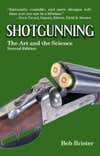Book Review: ‘Shotgunning: The Art and Science’
We may earn revenue from the products available on this page and participate in affiliate programs. Learn more › Anhinga...

We may earn revenue from the products available on this page and participate in affiliate programs. Learn more ›

Anhinga sagely commented on Wednesday’s post that Bob Brister’s “Shotgunning: The Art and Science” answers many of the ballistic questions that shotgunners argue over. Written by my predecessor as Field & Stream’s shotgun columnist, is available from Skyhorse Publishing in a reprinted edition, and the first edition can be found readily at Amazon.com and other online sellers. My copy is nearly worn out from repeated re-readings.
Brister was a great competitive and field shooter with an inquiring mind. The book is most famous for the work he did testing shotstrings. Shotstrings are hard to measure but Brister’s methodology was brilliantly simple: he rigged up an 18 foot trailer as a moving pattern board and had his wife tow it past him at right angles at 35 mph with a station wagon while he shot different loads at it. The patterns weren’t the round clusters we see on stationary pattern boards but elongated spreads reflecting the lag between the first and last pellets in a shotstring fired at a crossing target. Some of the patterns stretched almost from one end of the 18 foot sheet to the other. The book’s many photos of the moving patterns Brister clearly showed the effects of shotstringing especially with some of the lower quality magnum lead duck loads of the ’70s.
Brister’s book also includes some very interesting duck load lethality tables taken from Winchester’s Nilo Farms tests conducted in the 70s. Winchester engineers strapped game farm ducks to a moving track that ran past a full choke shotgun set to shoot when the duck passed it and tested it with different loads on 2,400 mallards. The results were then built into a computer model of shotshell lethality which is discussed thoroughly in the book. I asked about the track last time I went to Nilo and was told it still exists, but there is no way such a test would be conducted today.
Unfortunately, steel shot was in its infancy when this book was written (Brister was an early advocate of non-toxic shot during the heated debates of the ’70s) and I wish he had revised the book to cover improved steel loads, bismuth and tungsten-non-toxics, but unfortunately, he never did, although he covered many of those developments in the pages of Field & Stream.
The book is a very easy, non-technical read as well as a fascinating, and an indispensible addition to any shotgunner’s bookshelf.